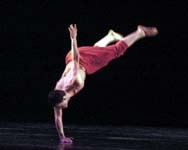
2005 Spring Dance Concert to feature four unique dance acts (Photo by Austin Kilgore, The Daily Campus)
The 2005 Spring Dance Concert opens tonight and continues through Sunday with shows at 8 p.m. Thursday through Saturday and a show at 2 p.m. on Sunday. Tonight’s show, however, begins at 7 p.m. in the Bob Hope Theater with a Martha Graham lecture demonstration presented by Myra Woodruff, chair for the division of dance. “Hope Show” tickets are $12 for adults, $9 for seniors and $6 for students.
This year’s concert features George Balanchine’s “Serenade,” artist-in-residence Max Stone’s “Kama Shastra,” Lester Horton’s “The Beloved” and Martha Graham’s “Helios.”
“Serenade” by George Balanchine
After coming to the United States in 1933, Balanchine founded the School of American Ballet which led him to choreograph his first American ballet: “Serenade.”
Shelley Berg, associate professor and director of graduate studies for the division of dance, said, “’Serenade’ is perhaps one of Balanchine’s most beautiful ballets.”
According to Berg, Balanchine was influenced by the speed of New York streets and the all-American girl. Through this, his movement became more contemporary.
“He exaggerated the transfer of weight from one leg to another, often bringing the hips and pelvis in to play,” she said.
By extending the line of the classical body, he created a “sleek look similar to modern skyscrapers.” In most classical ballets the body is rounded and romantic. In “Serenade,” however, the body looks “assembled and architectural.”
Balanchine considered the school his medium for training the dancers and thus incorporated certain events into his ballet that occurred during rehearsal.
“A girl late to the rehearsal was added to the re-statement of the opening … another dancer’s fall was incorporated into the end of the spirited ‘Russian Dance,’” Berg said.
“Kama Shastra” by Max Stone
Originally from Texas, Stone began his career in Neil Simon’s Broadway production of “They’re Playing Our Song.” In 1986, he formed his first company in Sweden before teaching and touring throughout Europe and Japan.
“Kama Shastra,” meaning “sexual discipline,” is a synthesis of ballet, jazz and modern techniques.
“I was intrigued by the East Indian Hindu texts of the Kama Sutra, which views sensuality and sexuality as, not only sacred, but as an art form,” Stone said.
Genie Stallings, costume designer, and Susan White, lighting designer, worked with Stone to match the choreography to create an overall somewhat mystical effect.
The piece features several sections, including duets and solos, divided by blackouts. One of the duets is between two men.
“I address … certain aspects of human sexuality, including homosexuality, within the framework of [the Kama Sutra],” he said.
The final movement of the piece is a “jazzy” section that’s “just my little commentary on our Western culture’s commercialized … use of the power of human sexuality.
After all, sex sells.
“The Beloved” by Lester Horton
One of America’s most controversial choreographers, Horton used diverse elements in his pieces to create realism and drama.
Created in 1949, “The Beloved,” according to associate professor Patty Delaney, was based on a news account of a man in the Bible belt who beat his wife to death with a Bible after accusing her of adultery. Horton’s choice of setting, Victorian New England, amplified the message.
“ … [The] message remains relevant through time,” Delaney said. “The rights of women always seem to suffer under religious fanaticism.”
The division of dance’s version features a interracial couple, graduate students Marlon Simms and Danna Reubin.
“I think that one of the reasons that Horton’s work was so powerful and controversial is because he had a mixed race company long before it was the norm,” Delaney said.
“Helios” by Martha Graham
Choreographed in 1981, “Helios” is the third movement from a larger work called “Acts of Light.” Graham was 86 years old when she created the piece.
Costume designer Stallings recreated the original gold unitards designed by Graham.
“Helios is a technically challenging work that employs advanced movement material,” Woodruff said. “Our dancers are handling the challenge admirably.”
The piece’s inspiration comes from a letter written by Emily Dickinson thanking a friend for the visit.
She wrote, “Thank you for all the acts of Light that beautifies a summer now past its reward.”
The work contains a famous floor work section that the students in the dance school learn in their modern classes.
“[This] is probably the most beautiful and joyous of all Martha’s creations,” Woodruff said.








